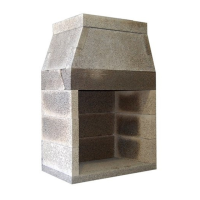69
Summary
1. WARNING:
Fire-Lite replace and Class “A” metal chimney sys-
tems will only draught properly when they are installed accord-
ing to the instructions, in an appropriate location and with the
proper chimney height. Installing the replace according to the
instructions, choosing an appropriate location, and choosing an
appropriate chimney
height are the responsibility of the designer and the building
contractor.
Tightly insulated and sealed homes, two story interior
spaces and high vaulted ceilings can cause negative air pressures
within the house which can impair drafting performance. HVAC
return air ducts near the replace opening will adversely affect
the replace drafting performance.
It is the responsibility of the designer, the building
contractor and their mechanical contractor to determine that the
building’s internal air pressures are conducive to positive re-
place drafting.
Avoid placing any replace in an area near tall trees, tall
buildings, or high land masses. These structures can reduce am-
bient air ow pressure as well as produce down draughts, either
of which can impair replace drafting performance.
Earthcore Industries L.L.C. does not warrant drafting
and is not responsible for it.
2. Magnum Fireplace and Fire-Lite Fireplace Curing
Instructions:
It is critical that the Isokern masonry elements in the
Fire-Lite rebox and smoke dome assembly be dry before r-
ing of the unit. Moisture left in the Fire-Lite components from
exposure during storage and shipping, as well as moisture from
the installation phase, must be eliminated before the unit is put to
its intended use.
The rst step in reducing the ambient moisture is to be
sure that the completed Fire-Lite replace rest totally in a dried-
in setting for a minimum of 28 days after construction of the unit
is complete.
The next step in curing the Fire-Lite replace is to be
sure that the rst ve or six res are of short duration.
The rst re of the unit can take place once the mini-
mum twenty-eight day drying period has passed. This re should
be especially short.
Start the rst re slowly with a small amount of paper
and kindling (small dry wood splits or twigs) and a maximum
load of four to six pounds of dry rewood, estimated to be no
more than two or three logs each of about three inches (3”) to
four inches (4”) diameter.
The rst re should burn for no more than thirty to sixty
minutes and then allowed to go out. Do not refuel the replace
during the rst lighting.
A cooling off period of twenty-four hours, at a mini-
mum, should follow the rst re.
The second re should be the same as the rst re.
The second re should burn for no more than thirty to
sixty minutes and allowed to go out. Do not refuel the replace
during the second lighting.
A twenty-four hour cooling off period must be
observed following second lighting.
After rst and second re, continue use of the unit with three
or four small res of short duration (sixty minutes or so) and
small fuel load.
After these rst ve or six small res of short dura-
tion normal use of the replace can proceed. For normal use
the maximum recommended fuel load is twelve to sixteen
pounds of dry rewood at a time. This fuel load is consid-
ered to be approximately three to ve cured hardwood logs
of about three inches (3”) to six inches (6”) in diameter. As
the re burns down, refueling should be only one or two logs
added at a time.
Important: Do not burn construction debris or trash of any
kind in the Fire-Lite replace.
Whereas it is not uncommon for construction debris
and refuse to be burned in a replace by site personnel on
a project that is under construction, this activity must be
avoided.
It is the responsibility of the building contractor
to insure that the required dry-in period is met and that the
required lighting sequence is performed by the owner or by
the owner’s agent.
3. Log grates are required for burning solid fuel in the
Isokern replace. Grates allow for easy air ow up through
the burning logs thus creating a more complete and efcient
burning of the fuel.
4. How to Build a Fire:
First set the replace damper in the full open posi-
tion. Begin laying the re by placing several pieces of wad-
ded up paper directly on the log grate. Place kindling (small
splits of dry pine or other dry softwood) on top of the paper,
enough to loosely cover the paper. Next arrange several
small, dry hardwood or softwood logs or log splits on top of
the kindling layer.
Finally, arrange two or three larger hardwood logs
(oak, hickory, etc.) or log splits on top of the stack.
Ignite the paper at the bottom of the stack. The burning
paper will ignite the kindling which will, in turn, set the
remaining fuel on re.
Be sure to stack all rewood in such a way that it
will settle into the log grate as the paper and kindling layers
are burned away. Additional logs can be set onto the re as
each fueling burns down.
Ideally, fuel logs should be of a hardwood species
that have been air dried for one year or longer. Use of cured
or uncured pine logs and uncured hardwood logs for fuel
should be avoided. Pine logs and uncured hardwood logs
will tend to smolder and burn at relatively low temperatures
producing high levels of soot and creosote.
Important: Do not throw, toss, jam, kick or otherwise force
logs into the Standard replace.

